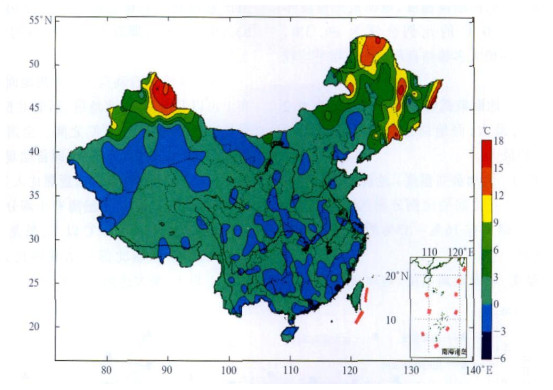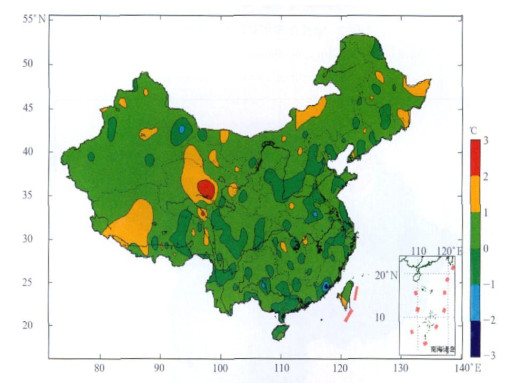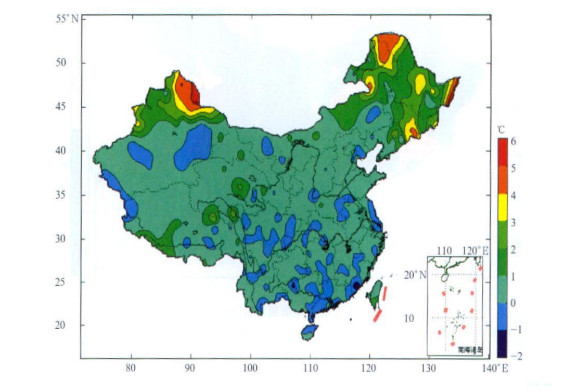自动观测与人工观测地面温度的差异及其分析
Differences Between Automatic-observed and Manual-observed Surface Temperature
-
摘要: 使用我国在人工观测向自动观测转变时原基本 (准) 站的平行对比观测及2005年基准站平行观测的地面温度资料, 进行了自动站观测与人工观测地面温度资料在日、月、年不同时间尺度上的差异分析。用最大似然率检验方法检验地面温度月值的均一性, 对自动观测影响地面温度均一性的程度进行了初步研究。分析结果表明:全国自动观测地面温度日平均值比人工观测高0.54 ℃。地面温度、地面最高温度、地面最低温度年对比差值大于0.0 ℃以上的比例分别为80.3%, 58.2%, 92.2%, 绝大多数站自动观测地面温度的年平均值比人工观测值高。自动与人工观测地面温度日差值从北到南逐渐减少, 45°N以北的黑龙江及内蒙古北部、新疆大部地区是自动与人工观测地面温度日差值平均最大的地区。自动观测与人工观测地面温度的差异在日、月、年的时间尺度上均表现为冷时段比暖时段的差异大, 北方冬季差异最为明显。其主要原因是在北方冬季有积雪时, 自动观测的地面温度是雪下温度, 比原人工观测的雪上温度明显偏高, 如果无积雪影响, 两种仪器观测的差异并不明显, 差值来源于两种仪器和场地差异的共同结果。非均一性检验表明:在北方地区地面温度产生非均一性的主要原因是自动站观测的变化; 而在南方地区, 自动观测的改变对地面温度非均一性影响不大。北方有积雪时, 观测的地面温度不能表现真实的地面温度, 因此, 在使用时要特别注意。Abstract: Based on the parallel comparison of original base stations during the transition from manual observation to automatic observation and the 0 centimeter temperature data from parallel observation of base stations in 2005 in China, the analyses are made on the differences between automatic-observed and manual-observed surface temperature data in time scales of day, month and year. The method of maximum likelihood ratio has been applied to test the homogeneity of the monthly values of 0 centimeter surface temperature. And the homogeneity of surface temperature affected by automatic observation is discussed. The results show that the daily mean value from automatic observation is 0.54 ℃ higher than that from manual observation in 0 centimeter surface temperature of China. The 0 centimeter surface temperature, 0 centimeter maximum and minimum surface temperature have annual comparison values over 0.0 ℃ with the percentage of 80.3%, 58.2%, 92.2%, respectively, and in most stations the automatic-observed annual mean value is higher than manual-observed one. The average daily value difference between auto and manual observation generally decreases gradually from north to south, and the average daily value varies the greatest in the north of Helongjiang Province and the north of Inner Mongolia to 45°N, and most areas in Xinjiang Autonomous Region. In all the time scales including day, month and year, the difference between automatic-observed and manual-observed temperature is greater in cold time period than warm time period, especially in the winter of the north. The main cause is that when there is snow covering the ground in winter, the surface temperature from automatic observation is the temperature under the snow, which obviously is higher than the temperature above snow from manual observation. If without the influence of snow cover, then there is no obvious difference between the two kinds of observation. The instrumental difference and the ground feature both contribute to the observational difference. The inhomogeneity test shows that the inhomogeneity from 0 centimeter surface temperature in the north area lies in the change of observation in automatic observing stations, while in the south, the change of observation does not exert much influence on the inhomogeneity of surface temperature. When there is snow cover in the north, 0 centimeter surface temperature from observation does not present the real situation, which should be taken into consideration while using the data.
-
Key words:
- automatic observing station;
- surface temperature;
- difference
-
表 2 各区基准站地面温度日对比差值的各统计量
Table 2 The statistical values of the comparative difference between daily surface temperatures of the standard stations in each area

表 3 全部站非均一性检验结果
Table 3 The inhomogeneity test result of all stations

表 4 各区非均一性检验结果
Table 4 The inhomogeneity test result of each area

-
[1] 张家诚.中国气候总论.北京:气象出版社, 1991:176. [2] 柏晶瑜, 徐祥德. 1998年青藏高原春季地温异常对长江中下游夏季暴雨影响的研究.应用气象学报, 1999, 10(4):478-485. http://qikan.camscma.cn/jams/ch/reader/view_abstract.aspx?file_no=19990493&flag=1 [3] 李栋梁, 吴青柏, 汤懋苍.青藏高原地表 0厘米温度的时空变化特征. http://www.chinainfo.gov.cn/data/200611/ [4] 李述训, 吴通华.青藏高原地气温度之间的关系.冰川冻土, 2005, 27(5):627-632. http://www.cnki.com.cn/Article/CJFDTOTAL-BCDT200505000.htm [5] Qi Hu, Song Feng. A daily soil temperature dataset and soil temperature climatology of contiguous United States. J Appl Meteor, 2003, 42(8):1139-1156. doi: 10.1175/1520-0450(2003)042<1139:ADSTDA>2.0.CO;2 [6] WMO. Guidelines on Quality Control Procedures for Data from Automatic Weather Stations. CBS/OPAG-IOS/ 2004, Geneva: WMO, 2004. [7] WMO. Report and Review about Data Processing and Quality Control Procedures Involved in the Conversion of Manually Operated Stations to Automatically Operated Station. WMO-TD No.833, Geneva: WMO, 1997. [8] WMO. Guidelines on Climate Observation Networks and Systems. WMO-TD No.1185, Geneva:WMO, 2003. [9] WMO. Guidelines on Climate metadata and homogenization. WMO-TD No.1186, Geneva:WMO, 2003. [10] NOAA. Automated Surface Observing System (ASOS) User's Guide. http://www.nws.noaa.gov/asos/aum-toc.pdf, 1998. [11] WMO. Guide to Meteorological Instruments and Methods of Observation. WMO-No.8, Geneva:WMO, 1996. [12] Ernest Rudel. Climate Data Continuity Using Automatic Weather Stations? Proceedings of ICEAWS 2003, Torremolinos, Spain, 2003. [13] 任芝花, 冯明农, 张洪政.自动与人工观测降雨量的差异及相关性.应用气象学报, 2007, 18(3):358-364. http://qikan.camscma.cn/jams/ch/reader/view_abstract.aspx?file_no=20070358&flag=1 [14] 胡玉峰.自动与人工观测数据的差异.应用气象学报, 2004, 15(6):719-726. http://qikan.camscma.cn/jams/ch/reader/view_abstract.aspx?file_no=20040689&flag=1 [15] 王颖, 刘小宁.自动站与人工观测气温的对比分析.应用气象学报, 2002, 13(6):741-748. http://qikan.camscma.cn/jams/ch/reader/view_abstract.aspx?file_no=20020697&flag=1 [16] Matthew J Menne, Claude E Duchon. Quality Assurance of Monthly Temperature Observations at the National Climatic Data Center. http://lwf.ncdc.noaa.gov/oa/hofn/coop/ams-13th-applied-climate.pdf, 2005. [17] Alexandersson Hans, Moberg Anders. Homogenization of Swedish temperature data. Part Ⅰ:Homogeneity test for linear trends. International Journal of Climatology, 1997, 17:25-34. doi: 10.1002/(ISSN)1097-0088 [18] 任芝花, 郭锡钦.浅层地温对比试验结果.气象, 1996, 22(11): 29-32. http://www.cnki.com.cn/Article/CJFDTOTAL-QXXX611.008.htm [19] 中国气象局.地面气象观测规范.北京:气象出版社, 2003: 35-46. [20] 潘守义.现代气候学原理.北京:气象出版社, 1994. -


 设为首页
设为首页 加入收藏
加入收藏



 下载:
下载:





